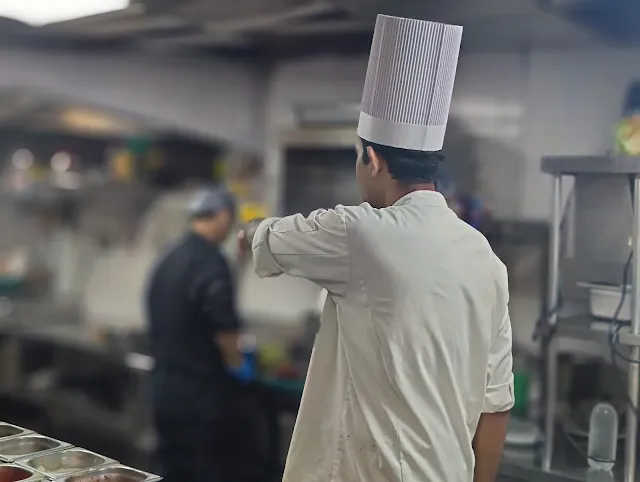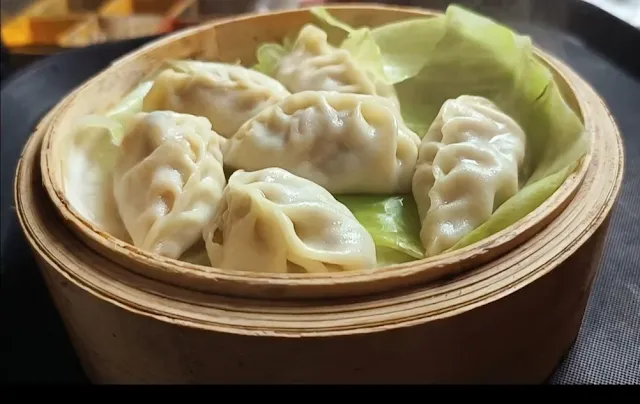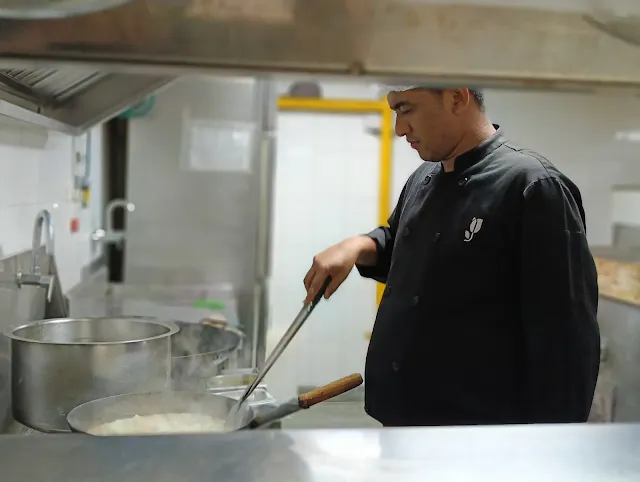What is a Sous Chef
Details about what is a Sous Chef
A sous chef is a culinary professional who holds a senior position in a professional kitchen, typically working under the executive chef or head chef. The term "sous" comes from French and means "under," reflecting the sous chef's role as second in command in the kitchen hierarchy.
What is a Sous Chef?
Sous Chef Full Form
The full form of "sous chef" is "sous-chef de cuisine." It is a French term that translates to "under-chef of the kitchen" in English. A sous chef is the second-in-command in a professional kitchen and works directly under the head chef. They are responsible for managing the kitchen staff, overseeing food preparation, ensuring quality and consistency of dishes, and assisting the head chef in various tasks related to menu planning and kitchen operations.
Key Responsibilities in the Kitchen
Menu Planning: Assist the head chef in designing and updating menus, experimenting with recipes and ingredients for seasonal or specialty dishes.
Staff Management: Supervise cooks, delegate tasks, resolve conflicts, and train new team members, stepping in for the head chef when needed.
Quality Control: Uphold high standards of food hygiene, taste consistency, and presentation throughout service.
Inventory Control: Monitor stock levels, order fresh supplies, and keep track of kitchen equipment.
Health & Safety Compliance: Ensure the kitchen complies with statutory food safety and sanitation requirements.
Leadership & Communication: Motivate the team, resolve daily challenges, and act as a mediator between kitchen staff and management.
Menu Planning: Assist the head chef in designing and updating menus, experimenting with recipes and ingredients for seasonal or specialty dishes.
Staff Management: Supervise cooks, delegate tasks, resolve conflicts, and train new team members, stepping in for the head chef when needed.
Quality Control: Uphold high standards of food hygiene, taste consistency, and presentation throughout service.
Inventory Control: Monitor stock levels, order fresh supplies, and keep track of kitchen equipment.
Health & Safety Compliance: Ensure the kitchen complies with statutory food safety and sanitation requirements.
Leadership & Communication: Motivate the team, resolve daily challenges, and act as a mediator between kitchen staff and management.
How to Become a Sous Chef
Enroll in diploma or degree programmes in Culinary Arts or Hotel Management after 12th grade. Top Indian institutes include NIPS, IHM Mumbai/Delhi/Bangalore, WGSHA Manipal, Le Cordon Bleu New Delhi, and Culinary Academy of India Hyderabad.
Diploma in Culinary Arts: 1–2 years, teaches essential cooking techniques, food safety, and kitchen management.
B.Sc. in Hospitality/Culinary Arts: 3–4 years, includes advanced culinary skills, people management, and menu planning.
Short certificate and postgraduate diplomas for specialisations like bakery, pastry, or international cuisines.
Start with entry-level roles like Commis Chef, Line Cook, or Kitchen Assistant, and actively seek promotions through hard work, passion, and skill development.
Start with entry-level roles like Commis Chef, Line Cook, or Kitchen Assistant, and actively seek promotions through hard work, passion, and skill development.
Learn stock management, food hygiene, budgeting, time management, and team leadership. Experience in multitasking and working under pressure is essential.
Leadership, communication, decision-making, and conflict resolution are vital for managing teams and creating a positive kitchen environment.
Sous Chef Job Opportunities
Sous chefs are in high demand in the Indian hospitality industry, catering to luxury hotels, restaurant chains, resorts, cruise liners, airlines, hospitals, and event/catering companies.
Five-star hotels (Taj, Oberoi, ITC, Marriott)
Fine-dining and specialty restaurants
Resorts and spas
International cruise liners and airlines
Large catering and foodservice companies
Corporate cafeterias and industrial kitchens
Five-star hotels (Taj, Oberoi, ITC, Marriott)
Fine-dining and specialty restaurants
Resorts and spas
International cruise liners and airlines
Large catering and foodservice companies
Corporate cafeterias and industrial kitchens
Types of Sous Chef
In a professional kitchen, a sous chef is the second-in-command, directly assisting the head chef in managing the kitchen and overseeing food preparation. There are different types of sous chefs based on the specific responsibilities they handle and the areas they focus on. Here are some common types of sous chefs:
- Junior Sous chef
- Sous Chef
- Executive Sous chef
These are some of the common types of sous chefs you may encounter in professional kitchens. The specific roles and titles can vary depending on the establishment's size, cuisine, and organization. Each type of sous chef plays a crucial role in the kitchen's overall success by contributing their specialized skills and knowledge to the culinary team.
Remember, becoming a sous
chef takes time and commitment. Be persistent, continue learning and honing
your skills, and always be open to feedback and growth.
Frequently Asked Questions
1. Is Chef higher than Sous Chef ?
In a traditional kitchen hierarchy, the Chef is higher than the Sous Chef. Here's how the typical kitchen hierarchy is structured:
Executive Chef : This is the highest-ranking chef in the kitchen. They are responsible for overseeing the entire kitchen operation, including menu creation, managing the kitchen staff, and ensuring the quality and consistency of the dishes.
Sous Chef : The Sous Chef is the second-in-command and directly assists the Executive Chef. They are responsible for supervising the kitchen staff, coordinating cooking processes, and often step in to menu creation, managing the kitchen staff, and ensuring the quality and consistency of the dishes.
Chef de Partie (Station Chef) : Each Chef de Partie is in charge of a specific section or station in the kitchen, such as the sauce station, grill station, pastry section, etc. They report to the Sous Chef.
Commis Chef : These are junior chefs who work under the supervision of the Chef de Partie. They assist with basic food preparation and cooking tasks.
The hierarchy can vary depending on the size and structure of the kitchen, but in most cases, the Chef outranks the Sous Chef. The Chef de Partie and Commis Chef positions also have varying levels of authority and responsibility within their respective sections
2. Who is commis Chef?
A Commis Chef is an entry-level position in a professional kitchen, and it is one of the first steps in the culinary career ladder. The word "commis" is derived from the French term for "assistant." Commis Chefs work under the supervision of more experienced chefs and are responsible for assisting in various food preparation tasks.
3. What is the highest rank of Chef?
The highest rank of a chef in the culinary world is often referred to as an "Executive Chef" or "Chef de Cuisine." This position is the pinnacle of the kitchen hierarchy and comes with significant responsibilities and authority.
3. What is the highest rank of Chef?
The highest rank of a chef in the culinary world is often referred to as an "Executive Chef" or "Chef de Cuisine." This position is the pinnacle of the kitchen hierarchy and comes with significant responsibilities and authority.
Difference between Executive Chef vs Sous Chef
In the culinary world, the roles of an executive chef and a sous chef are both important and integral to the smooth functioning of a kitchen. They have distinct responsibilities and positions within the kitchen hierarchy. Let's explore the differences between the two:
Executive Chef:
- The executive chef is the head chef, also known as the chef de cuisine, in charge of the entire kitchen operation. They are responsible for overseeing all aspects of food preparation, menu planning, and kitchen management.
- Menu Planning: The executive chef is usually the one responsible for creating and designing the menu. They may develop new dishes, ensure variety and quality, and consider customer preferences and dietary requirements.
- Kitchen Management: They handle the overall organization of the kitchen, including staffing, scheduling, and maintaining a clean and safe working environment.
- Decision Making: The executive chef makes crucial decisions related to ingredient sourcing, equipment purchases, and the general direction of the culinary offerings.
- Culinary Vision: They are often the driving force behind the culinary vision of the restaurant, and they strive to ensure consistency and excellence in food quality.
- Creativity: Executive chefs usually have a strong culinary background and bring creativity to the kitchen, elevating the dining experience for customers.
Sous Chef:
The sous chef is the second-in-command in the kitchen, reporting directly to the executive chef. The term "sous" is French for "under," indicating their position.
- Food Preparation: Sous chefs are heavily involved in food preparation, supervising the cooking process, and ensuring that dishes are made to the executive chef's specifications.
- Kitchen Coordination: They assist in managing the kitchen staff, ensuring that everyone works efficiently and cooperatively. This may include training new cooks and delegating tasks.
- Quality Control: Sous chefs play a key role in maintaining food quality and presentation. They may taste dishes to ensure they meet the restaurant's standards.
- Temporary Leadership: In the executive chef's absence, the sous chef may assume temporary leadership and oversee kitchen operations.
- Inventory and Ordering: Sous chefs are often involved in monitoring inventory levels and may help with ordering ingredients and supplies.
In summary, the executive chef is the top authority responsible for the overall culinary direction and management of the kitchen, while the sous chef is the immediate assistant who oversees day-to-day operations, ensuring that the executive chef's vision is executed efficiently and consistently. Both roles are vital for a successful and well-functioning kitchen in a restaurant or culinary establishment.
Kitchen Hierarchy (hierarchy of Chefs in a restaurant)
The kitchen hierarchy, also known as the kitchen brigade system, is a structured organization commonly used in professional kitchens to ensure smooth operations and effective management of culinary tasks. This system was popularized by the French chef Georges Auguste Escoffier and has been widely adopted in restaurants and hotels around the world. While the exact structure and titles may vary depending on the size and type of kitchen, the following is a typical representation of the kitchen hierarchy from top to bottom:
- Executive Chef: The head chef or executive chef is the top authority in the kitchen. They are responsible for the overall management, menu planning, and coordination of the kitchen operations. The executive chef also oversees the preparation of dishes to maintain quality and consistency.
- Sous Chef: The sous chef, also known as the second-in-command, assists the executive chef in various tasks. They often handle kitchen staff supervision, training, and scheduling. The sous chef also ensures that the kitchen operations run smoothly in the absence of the executive chef.
- Chef de Cuisine (Head Chef): In larger establishments, there might be a chef de cuisine who directly manages the day-to-day operations of a specific kitchen area (e.g., hot kitchen, cold kitchen, pastry). They report to the executive chef or sous chef and are responsible for their designated section.
- Chef de Partie (Station Chef): The chef de partie is in charge of a specific section or station within the kitchen, such as the grill, sauté, pastry, or vegetable section. They oversee the preparation of dishes within their station, maintain quality, and manage any junior staff working with them.
- Commis Chef: Commis chefs are junior chefs who work under the supervision of the chef de partie. They assist in food preparation, cooking, and other kitchen tasks, gaining experience and skills as they advance in their culinary career.
- Kitchen Apprentices: Apprentices are aspiring chefs or culinary students who work in the kitchen to gain practical experience. They often rotate through various stations to learn different aspects of cooking and kitchen management.
- Kitchen Porter/Dishwasher: The kitchen porter, also known as a dishwasher, plays a crucial role in maintaining kitchen cleanliness. They are responsible for washing dishes, utensils, and keeping the kitchen area tidy.
Sous Chef skills
A sous chef is a key member of the kitchen brigade and plays
a crucial role in assisting the executive chef in running a smooth and
efficient kitchen operation. To excel as a sous chef, one should possess a
diverse set of skills, including culinary expertise, leadership abilities, and
strong organizational capabilities. Here are some essential sous chef skills:
- Culinary Knowledge: A sous chef must have a strong foundation in culinary arts, including a deep understanding of various cooking techniques, ingredients, and flavors. They should be skilled in preparing, cooking, and presenting a wide range of dishes.
- Food Safety and Hygiene: Maintaining high standards of food safety and hygiene is paramount in a professional kitchen. Sous chefs should be well-versed in food safety regulations and ensure that the kitchen team follows them meticulously.
- Leadership and Management: As a second-in-command, a sous chef must exhibit excellent leadership and management skills. They should be able to motivate and guide the kitchen staff, delegate tasks effectively, and maintain a positive work environment.
- Time Management: In a fast-paced kitchen environment, time management is crucial. A sous chef should be adept at prioritizing tasks, working efficiently, and meeting deadlines to ensure that dishes are prepared and served on time.
- Communication: Effective communication is essential for seamless coordination between different kitchen stations and the front-of-house staff. A sous chef should be able to communicate clearly and assertively to avoid misunderstandings and errors.
- Menu Planning and Development: Sous chefs often assist in menu planning and may be involved in creating new dishes. They should have a good understanding of food trends, customer preferences, and cost considerations.
- Problem-Solving: Kitchen scenarios can be unpredictable, and a sous chef should be skilled at thinking on their feet and finding creative solutions to challenges that may arise during service.
- Kitchen Equipment Proficiency: Sous chefs should be familiar with various kitchen equipment and tools, ensuring that they and their team use them correctly and maintain them appropriately.
- Team Player: Being a team player is essential in a busy kitchen. A sous chef should collaborate well with other kitchen staff, respect their contributions, and foster a harmonious work atmosphere.
- Adaptability: Kitchens can be dynamic environments, with changing menus, events, and unexpected situations. A sous chef should be adaptable and remain composed under pressure.
- Cost Control: Understanding the importance of cost control is vital for a sous chef. They should be mindful of food waste, portion sizes, and proper storage to optimize resources and minimize expenses.
- Training and Development: As a leader in the kitchen, a sous chef may be involved in training and developing junior chefs and kitchen apprentices.
These skills, combined with
passion, dedication, and a commitment to excellence, contribute to the success
of a sous chef in a professional culinary setting.
A brief history of CHEF
The history of chefs and culinary arts is rich and diverse, spanning centuries and cultures. The term "chef" comes from the French word "chef de cuisine," which translates to "chief of the kitchen." Here's a brief overview of the history of chefs:
Ancient Culinary Practices: The roots of culinary arts can be traced back to ancient civilizations such as the Mesopotamians, Egyptians, Greeks, and Romans. In these early societies, cooking was a fundamental skill, and individuals responsible for food preparation were highly regarded.
The Rise of Professional Cooks: With the emergence of more complex societies and elaborate dining customs, specialized culinary roles began to develop. In ancient Rome, for example, there were "cooks" (coqui) who were valued for their culinary expertise.
Medieval Kitchens: In the Middle Ages, culinary practices evolved further. The feudal system and the establishment of grand households brought about the emergence of professional cooks who worked in the kitchens of nobles and royalty.
The Renaissance and Haute Cuisine: During the Renaissance period, culinary arts saw significant advancements, especially in the royal courts of Europe. The French and Italian courts were particularly influential in shaping culinary techniques and creating elaborate dishes, setting the stage for what we now know as "haute cuisine."
The Birth of Modern Restaurants: In the 18th century, the concept of public eating establishments gained popularity in France. The first modern-style restaurant is believed to be "La Grande Taverne de Londres," opened in Paris in the late 1700s by Antoine Beauvilliers. The restaurant offered a diverse menu and professional chefs to prepare the dishes.
Culinary Schools and Professionalization: In the 19th century, the culinary profession began to be formalized. The first culinary school, Le Cordon Bleu, was founded in Paris in 1895. This marked the beginning of culinary education and the standardization of culinary techniques.
Celebrity Chefs and Modern Cuisine: The 20th century saw the rise of celebrity chefs, such as Auguste Escoffier and Julia Child, who brought culinary arts into popular culture through television and books. The globalization of cuisine and the fusion of culinary traditions from different regions also became prominent during this period.
Contemporary Culinary Scene: In recent decades, the culinary world has seen rapid growth, with the advent of molecular gastronomy, farm-to-table movements, and increased interest in diverse cuisines from around the world. The role of chefs has expanded beyond the kitchen, with many becoming advocates for sustainable and ethical food practices.
Today, chefs continue to play a vital role in shaping food culture, experimenting with new ingredients and techniques, and delighting diners with their creations. The profession of a chef is highly respected and continues to evolve with changing food trends and consumer preferences.
It's essential to note that while this hierarchy provides a traditional framework, some modern kitchens may adopt a more flexible and collaborative approach, encouraging teamwork and communication among all members of the kitchen staff. The kitchen brigade system, nevertheless, remains a fundamental model for organizing large-scale culinary operations.
Popular Chefs dishes are

NICE TO MEET YOU!
I’m Mobasir Hassan, Executive Sous Chef with the Radisson Hotel Group. After years in hotel kitchens, I now share chef-tested recipes, step-by-step cooking techniques, and restaurant-style dishes that home cooks can recreate with confidence. I’m glad you’re here!










